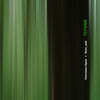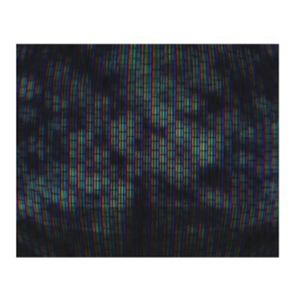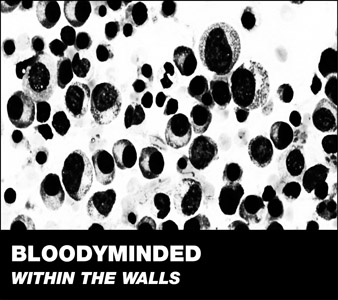- Administrator
- Albums and Singles
 Scott Morgan's latest album is quite a surprise, at least by Loscil’s eternally understated standards.  Partially inspired by hearing Philip Glass’s  Koyaanisqatsi score on a worn VHS tape, Monument Builders finds Loscil being a pulled in a number of different directions at once while still being held together by the unifying thread of Morgan's warmly hissing and elegantly blurred production aesthetic.  The result is quite an atypically epic and chameleonic Loscil album, but the material is strong enough to quell most of my misgivings about Morgan's stylistic tourism.
Scott Morgan's latest album is quite a surprise, at least by Loscil’s eternally understated standards.  Partially inspired by hearing Philip Glass’s  Koyaanisqatsi score on a worn VHS tape, Monument Builders finds Loscil being a pulled in a number of different directions at once while still being held together by the unifying thread of Morgan's warmly hissing and elegantly blurred production aesthetic.  The result is quite an atypically epic and chameleonic Loscil album, but the material is strong enough to quell most of my misgivings about Morgan's stylistic tourism.
Scott Morgan’s work has always tended towards the melancholy side, but Monument Builders is a bit more unambiguously dark than he has been in the past.  Aside from Glass, this album was also inspired by philosophy and art that explored the transience of humanity and the perverse and unintended beauty that we leave in our wake.  It is especially easy to see how the latter theme might resonate especially strongly with Morgan, as he has long been fascinated with distressed and decayed sounds: Edward Burtynsky's distressed and decayed landscapes depicted on such a grand scale are not entirely unlike Morgan’s own, albeit in a different medium and at a much different scale.  That said, however, Morgan does seem to be wrestling with the idea of crafting something epic here, albeit within the decidedly non-epic Loscil aesthetic of dub techno slowed to a near-ambient crawl.  A few pieces still seem largely content with business as usual though, such as the brooding and slow-burning opener "Drained Lakes," which marries a simple minor-key melody to a muted kick-drum pulse and some subtly harsh and grinding swells.  Gradually, the piece fleshes out into more lush territory, but not without a brief interlude of uncharacteristic starkness and muted catharsis.
Morgan’s "lo-fi Glass" fixation kicks in in earnest with the next piece though, as the obsessively repeating and propulsive arpeggios and somber brass textures of "Red Tide" sounds unapologetically like Glassworks played through a thin haze of static.  While Morgan basically appropriated Glass's style wholesale, he at least manages to make his pastiche good enough to stand with the real thing.  That quixotic Glass obsession resurfaces yet again with "Anthropocene," though Morgan is able to inject a bit more of his own aesthetic into it this time around by adding a skipping kick-drum beat.  Elsewhere, the Glass influence and Morgan's newfound propensity for grand gestures generally just manifest themselves as mournful horn motifs looming above Loscil’s usual crackling, slow-motion dub.  My favorite pieces tend to be those that avoid the Glass influence entirely though, even if they do maintain the album's elegiac tone.  "Deceiver," for example, is initially a very simple and melancholy synth progression, but it eventually blossoms into a hauntingly strangled and corroded-sounding melody.  Elsewhere, the closing "Weeds" completely wrong-footed me by unexpectedly channeling Love Streams-era Tim Hecker with a gorgeous crescendo of stuttering and chopped angelic voices.  It is unfortunate that such a comparison is totally unavoidable, but it is an absolutely wonderful piece regardless and an unexpectedly appropriate and rapturous way to conclude such an otherwise bleak album.
Obviously, the primary flaw with Monument Builders is that it is so nakedly derivative in places, but Morgan perversely manages to cumulatively build something rather original from his co-mingled architecture of Loscil and borrowed iconic aesthetics.  Whether it was a conscious decision or not, Morgan has essentially composed his own Koyaanisqatsi score, albeit for an imaginary dystopian version directed by Edward Burtynsky.  As such, Monument Builders is a much more fascinating release than a more distinctly "Loscil" album might have been.  Besides, compositional originality has never been a part of Loscil's appeal for me at all–I have always been drawn to Morgan's work primarily for its craftsmanship and masterful attention to textural detail, production-wise.  That is where Morgan has always shined and he shines yet again here.  Also, he definitely gets points for ambitiously straining at the seams of his own aesthetic and trying to do something new, even if the results feel a bit transitional (some fans will definitely find the previously reliable Morgan’s transformation a bit jarring).  Morgan may have made some stylistic missteps along the way with this record, but they were at least in service of a significant and satisfying artistic statement: Monument Builders is admirably more than "yet another Loscil album."
Samples can be found here.
Read More
- Administrator
- Albums and Singles
 While the title is in reference to the source material (field recordings in Ancient Olympia, Greece), it also serves as an appropriate name for these two monumental artists coming together. Linked only by the use of the same raw materials, both Lopez and Thanasis Kaproulias create very different, yet powerful worlds of sound.
While the title is in reference to the source material (field recordings in Ancient Olympia, Greece), it also serves as an appropriate name for these two monumental artists coming together. Linked only by the use of the same raw materials, both Lopez and Thanasis Kaproulias create very different, yet powerful worlds of sound.
Lopez's contribution, "Untitled #249," begins extremely quiet, remaining mostly silent until the most distant spectral drones slowly come into focus.In the earlier moments, there’s more of a ghostly warmth than the clinical digital sound I associate with Lopez's work.It eventually transitions into sharp, digital realms and harsher textures, though above an almost rhythmic clattering.
The dissonance peaks around the middle of the 30 minute work, with metallic scraping noises amidst a disorienting haze.Once it goes as loud as it can get, it slowly fades away, retreating and ending in a sparse, open field of sound, with the tiniest fragments of what was just heard remaining.
Novi_sad's half of the album, "Ellipsis," relies less on subtlety and more on variation.While it begins with slow motion, hollow noises and distant, almost thunder-like crashes that reverberate into infinity, it soon expands outward and allows the underlying field recordings to be heard.Transitioning from rushing water into a swarm of insects (though heavily processed), it builds layer by layer in intensity.
However, as the noisier elements are piling up, an almost melodic undercurrent surfaces: possibly a bit of folk music that found its way onto the tape, which is mangled into a beautiful drone, continuing to echo within caves of rushing water.The piece ends in the exact opposite way of Lopez's:it sounds like all of the previous layers of noise are stacked atop each other to create an intense cacophony that only ceases when the disc does.
Even though the only thing linking these two pieces are the source material, with each artist processing the field recordings in drastically different ways, the two pieces feel like they belong with each other.While their approaches to utilizing the source material may differ, the undeniable strength of both the young composer and the prolific veteran is prominent.
samples:
- Francisco Lopez - Untitled #249 (Excerpt 1)
- Francisco Lopez - Untitled #249 (Excerpt 2)
- Novi_sad - Ellipsis
 
Read More
- Administrator
- Albums and Singles
 Paring a recently released new work with a digital-only remastered reissue from the label, there is a decade of time elapsed between these two compositions, in which Roden’s evolution as an artist can be heard, particularly in his use of digital processing and composing.
Paring a recently released new work with a digital-only remastered reissue from the label, there is a decade of time elapsed between these two compositions, in which Roden’s evolution as an artist can be heard, particularly in his use of digital processing and composing.
Proximities is the result of a live synth performance recorded within a former army barracks, captured on a digital recorder, an iPhone, and an old microcassette recorder.The sparse sounds were then layered and placed alongside each other, with a simple tone progression expanded into a complex whole.
The piece opens with Spartan layers of sound: slowly rising and falling washes of synth tones mirroring the haze of the early morning, when the raw material for this work was recorded.There is a slow build, eventually paring the fragile synthetic tones with a grimier, dirty underbelly, likely sourced from lo-fi audio detritus.
The tones are slow and structured, and while they are somewhat repetitive, there is a constant flow: a river of sound that never stands still.As the piece comes to its conclusion, there is an even greater sense of chaos and fluidityWhile the basic tonal structure stays constant, everything around it disintegrates and eventually only the hollow environment in which recording took place can be heard.
Forms of Paper was released by Line in 2001, remastered by Bernard Guenter and reissued as a high quality download.While it was one of the heralding works of the "lowercase" genre (a genre of which the boundaries and parameters I never fully understood), there is far too much complexity for it to be pigeonholed into a label that would imply that nothing happens in the recording.
In fact, quite the opposite is true:although the piece takes a while to make itself known, Roden's processing of the sound of book pages becomes a world of subtle beeps and tones, with a greater focus on textures.While there is a more significant shifting between busy and sparse, it is a more repetitive work in comparison to Proximities.Not surprising since, in the accompanying essay, Roden points out that this was his first work utilizing Pro-tools rather than just analog tape, and that at the time he was quite fond of using copy and paste in composition.
While Roden may have begrudgingly entered the world of computer composition on Forms of Paper, his proficiency in its use is obvious within Proximities.The careful balance of tones and ambience are compelling and demand close attention, with a satisfying payoff.
samples:
 
Read More
- Administrator
- Albums and Singles
 Zola Jesus (effectively Nika Roza Danilova) made a huge artistic leap in 2010, transitioning from the lo-fi, gothic post-punk of The Spoils to the sweeping, synth-driven drama of her twin EP releases, Stridulum and Valusia. The two EPs were a grand step forward for Danilova, upping the drama quotient with two fistfuls of dark, cinematic songs. Conatus continues her winning streak, functioning as a distillation and subtle refinement of the ideas put forward on last year's EPs.
Zola Jesus (effectively Nika Roza Danilova) made a huge artistic leap in 2010, transitioning from the lo-fi, gothic post-punk of The Spoils to the sweeping, synth-driven drama of her twin EP releases, Stridulum and Valusia. The two EPs were a grand step forward for Danilova, upping the drama quotient with two fistfuls of dark, cinematic songs. Conatus continues her winning streak, functioning as a distillation and subtle refinement of the ideas put forward on last year's EPs.
The album kicks off with "Swords," a prelude of clattering electronic percussion, bass punches, and a first taste of that voice—the most majestic, operatic thing this side of Diamanda Galás, it casts a dominant shadow over her music in a similar manner. On Conatus, Danilova has finally mastered the balance between her vocal strengths with her compositional abilities, in conjunction with co-producer Brian "Nudge" Foote. The two flesh out the album with a wonderfully diverse palette of sounds: tightly wound electronics, church organ-like synths, cello and violin, deep wobbly bass, and occasional industrial clatter.
Throughout Conatus, Danilova's voice is bathed in hazy reverb; at times it sounds like she's crooning to the heavens within a cathedral, at others she sounds like a spectre. She tries new tricks, notably chopping her voice to bits (see the intro to "Vessel," the album's catchy first single) and swimming within the album's interweaved electronics and stark beats. Elsewhere, she spotlights herself among piano, strings, and pulsing synths, like on "Hikikomori," the album's high point. Later, "Skin" is Danilova's most vulnerable moment yet on record, without anything to hide behind—just a few resonant piano chords, and her own ethereal background vocals.
Like much first-wave post-punk, to which Zola Jesus is clearly indebted, Conatus is at its most enjoyable when Danilova's hooks are at their most hummable. As the album progresses, a couple of its tracks come off as faceless and forgettable—typically in direct proportion to the hook quotient, or lack thereof. For example, "In Your Nature" is a pleasant Xerox of Danilova's ballad style, but lacks a memorable chorus to keep it from sinking. And while there's nothing quite as massive as Valusia's "Sea Talk" on Conatus, "Lick the Palm of the Burning Handshake" comes damn close, with a militaristic drumbeat backing Danilova's insistent vocals, peaking with a punchy chorus: "The need to know, it takes you over / the need to grow, it takes you under / again and again, it takes you over."
Samples:
Read More
- Administrator
- Albums and Singles
 Sebastian Banaszczyk has been strongly refining his craft in "sound recycling," or essentially utilizing limited, conceptually relevant recordings as the only basis for compositions. These two separate albums, for two distinctly different dramatic performances, have some consistencies between them, but each stand on their own as distinct works, as well as representing the next stage in Bionulor's discography.
Sebastian Banaszczyk has been strongly refining his craft in "sound recycling," or essentially utilizing limited, conceptually relevant recordings as the only basis for compositions. These two separate albums, for two distinctly different dramatic performances, have some consistencies between them, but each stand on their own as distinct works, as well as representing the next stage in Bionulor's discography.
Coriolanus is a modernized take on Shakespeare's drama, while SKAZAna is a biographical piece of a girl sexually abused by her stepfather, so both are drastically different in content, with neither being light works.Banaszczyk himself is an actor, and thus he approached both scores from a different perspective than just a composer would, which strengthens that bond between score and performance expertly.
Coriolanus is the longer of the two works at nearly 78 minutes and 26 untitled pieces, with the original source material extracted from classical instruments subjected to heavy processing and treatments.The use of traditional sounds and instruments subjected to modern composition fits well with the modernized approach to the theatrical work it was composed for as well.
While the actual instruments sampled and used remains ambiguous, hints of melody and music drift throughout the album, often times just out of focus or interrupted by outbursts of digital interference or noise.On the sixth and 12th pieces especially what almost sounds like a piano appears frequently. On the latter, Banaszczyk tosses in some raw, jarring noise bursts to keep things from becoming too comfortable or complacent.
The 14th piece, clocking in at a bit over ten minutes is definitely the lengthiest, and with that duration Banaszcyzk allows the heavily treated tones and textures to drift outward extensively, with the resulting composition sounding more in line with some of the earliest electro-acoustic and electronic composers in its slow build and nuance.
samples:

For SKAZAna, the source material is the voice of writer and actress Sylwia Oksiuta, and the sound recycling pulls it into a world that has pretty much no semblance of humanity about it.Much of the melody or hints of musicality from Coriolanus are gone, replaced instead with disembodied noises or mangled low bit rate samples.The second and third parts especially are all a series of stuttering, delayed clatters and haunting, frigid swells of sound bathed in what sounds like spring reverb.
This album is much more about texture and noise rather than tone, with echoing bits and windy passages of noise creating a cold, isolated atmosphere that fits the subject matter perfectly.Some pieces seem to capture Oksiuta's breath, processed and stretched into hissy static and harsh, noisy outbursts.It is only on two pieces (the 17th and 20th) that other sources are used, the former consisting of fragile, bell like noises and ringing sounds, while the latter is surprisingly traditional, with a slew of strings and orchestral instrumentation bringing the score to a rather conventional coda.
While I was not able to experience any of the visual components to these performances, Banaszczyk's audio accompaniment works well enough as stand alone compositions.The recurring themes and sounds that appear throughout is perhaps the best clue that these are not necessarily albums independent of their original application, but that is only rather noticeable on Coriolanus, and even then it is not repetitive to the point of being a problem.Having followed Bionulor's work roughly since the project's inception, it has been a strong trajectory of evolution, with each work showing more and more expertise in both his use of sounds and his overall compositions, and these two works are no different.
samples:
 
Read More
- Administrator
- Albums and Singles
 On their first album in seven years, the multinational power electronics band fronted by US legend Mark Solotroff manage to live up to the hype created from their less than prolific release schedule. Punishing, malicious, and appropriately deranged, Bloodyminded proves they have lost none of their potency.
On their first album in seven years, the multinational power electronics band fronted by US legend Mark Solotroff manage to live up to the hype created from their less than prolific release schedule. Punishing, malicious, and appropriately deranged, Bloodyminded proves they have lost none of their potency.
Solotroff and his team have consistently managed to elude the two major clichés of the power electronics genre: intentionally ambiguous politics and overdone sexual violence.While his former project Intrinsic Action may have delved a bit into the latter, Bloodyminded have continued to shed the adult bookstore sleaze elements and instead have shifted into more varied, esoteric topics and themes, often tied to a voyeuristic examination of human psychology. Within the Walls, for example, has lyrical content heavy on cell biology, without ever becoming completely clear as to its symbolism or meaning.
Live, Bloodyminded manages to convey an image that is self-aware enough at its own spectacle without overly diving into parody or satire.Solotroff's aggressive vocals delivered via a cobra's nest of intertwined microphones as the rest of the band thrashes about with antiquated plastic synths is definitely idiosyncratic (recent photos show an adoption of the pocket sized Korg Monotron synths, which just add to the absurdity).With the band's thrashing and leather clad wardrobes, it comes across as a perfect perversion of heavy metal tropes.On record though, this is not as overt but admittedly is not at all necessary to appreciate the music.
Insanity, another staple of the Bloodyminded repertoire is also insinuated quite often throughout the 13 songs on this disc.The consistent use of multiple vocalists aggressively screaming mantra-like lyrical passages amidst the constantly shifting and roaring waves of electronics is the best approximation of schizophrenia I can imagine.Even with the near melody that is buried deep in the mix, "Fatal Breath" demonstrates enough contrast with the razor sharp electronics and feedback, offset by a deep low end rumble that makes everything extremely disorienting.On "Circular Relations" the sense of mental disconnect is even more powerful, with Solotroff's up front screams offset by Isidro Reyes' backing Spanish vocals creating a confusing juxtaposition.
One of the hallmarks of power electronics is use of rhythm, which "Night Strikes" chooses to completely ignore.Other than the sustained electronics, growled vocals and feedback keep things as hyperkinetic and unpredictable as the best Masonna records do."Disintegration" features more of a structure in comparison, with blasts of white noise and deep pulsing electronics that convey some sense of order, but with a vocal delivery that is ridiculously over the top, but works quite well.
The most significant departures here come at the beginning and end of the record.Opener "All the Cities are Occupied" is all murky hums and idling machinery noise.Compared to what follows it, it has a meditative, understated sensibility to it that sets the mood for what follows.Even though it begins to get abrasive about half way through, the intermingling layers of synths are much more restrained in contrast to the remainder of the record.
The album closes on a cover of Locrian's "Inverted Ruins," a song that Solotroff did the vocals for on their Territories album.In the hands of Bloodyminded, it maintains much of its original moody vibe, all based on layers of synthesizer that never become too harsh or unstructured, but with a looser overall feel.Stripped of its original rock trappings, the underlying electronics of the original become more prominent and gives an entirely different sound that honestly feels a bit between traditional Bloodyminded and Solotroff's Anatomy of Habit project.The orderly arrangement seems to insinuate an inevitable explosive climax, but it never comes.
With Whitehouse seemingly done for good, Solotroff and crew have put together an album that covers similar ground and hits the same high points without sounding like an emulation or a tribute.Even after such a break, Bloodyminded is still a singular force in a genre with far too many sound alikes.Within the Walls is cerebral enough to fascinate, visceral enough to pummel, and manically unhinged enough to be completely engrossing and entertaining.
samples:
 
Read More
- Administrator
- Albums and Singles
 This EP pretty much picks up exactly where last year's fine Man With Potential left off, once again combining furiously thumping house beats with stuttering, skittering noise.  It is more of a tease than a substantial effort though, as it is basically just an amusing dalliance with the 12" single format, consisting of two versions of the title piece and a superior B-side.  Neither quite stands with the best songs on Potential and there is no evidence of a significant stylistic evolution, but Pro Style is an enjoyable distraction to tide me over while I await Swanson's next major work.
This EP pretty much picks up exactly where last year's fine Man With Potential left off, once again combining furiously thumping house beats with stuttering, skittering noise.  It is more of a tease than a substantial effort though, as it is basically just an amusing dalliance with the 12" single format, consisting of two versions of the title piece and a superior B-side.  Neither quite stands with the best songs on Potential and there is no evidence of a significant stylistic evolution, but Pro Style is an enjoyable distraction to tide me over while I await Swanson's next major work.
The opening version of "Pro Style" begins with roughly a minute of grinding mechanized noise, brooding synths, and host of distinctly Swanson-esque buzzes, bleeps, and stutters before the beat kicks in.  My hostility towards four-on-the-floor house beats has already been documented and that has not changed, so the unrelenting, unchanging thump is a bit of a sticking point for me.  Even so, I eventually warmed to the piece somewhat, as the combination of the minimal, deep bass groove and the absurdly maximalist wrongness surrounding it is damn endearing.  I especially enjoyed the impressive invasiveness of the crunching, metallic noises that appear in the middle–it feels like being at a rave in the midst of an active, functioning junkyard (albeit one that also seems to be embroiled in a ferocious laser battle).  The "VIP" version that follows is essentially more of the same, but longer, uglier, and crunchier.  Which is, of course, even better.
The lengthier "Do You Like Students?" is a bit more closely aligned to my taste though, as Swanson thankfully tones down his rib-cage rattling bass drum a bit.  Also, it scores something of a perverse, improbable hook in its eerie, two-note synth pattern.  It also boasts a somewhat more ambitious and musical synth bass line, which makes it feel more like an actual song once the beat kicks in (rather than an assault by percussion).  The sounds in the periphery, for the most part, remain consistent with those in "Pro Style," although the various bleeps, stutters, and clatters are buried a bit deeper in the mix.  It may not sound like much of a divergence, but cumulatively, it makes a big difference: "Do You Like Students?" sounds like a perfectly likable bit of retro-dance pop that has been remixed by an insane person and has gone badly off the rails.  That distinction makes it significantly more enjoyable than something that is basically a noise piece with a house beat added.
While the music itself is solid, the real appeal of Pro Style lies in its simultaneously kitschy and reverent format.  This is presumably as close to "fun" as a Pete Swanson release can get, so it is hard to be too critical–this is not meant as any sort of grand statement.  Unfortunately, I am congenitally dissatisfied, so I have to admit that I am a little disappointed that Swanson did not embrace the potential of the 12" dance single more fully.  For example, I bet a dub version of "Do You Like Students?" could be spectacular.  Also, it probably would have been extremely cool (or memorably, hilariously awful) to enlist an influential but forgotten techno or dub producer to rework "Pro Style" rather than presenting two somewhat similar versions.  So many missed opportunities.  Alas.  Perhaps Pete might just be getting started with this format though–it works well for him, as this is exactly the right amount of harsh noise-damaged techno I can enjoy in one dose.  I will keep my fingers crossed.  In any case, Pro Style is very likable (if minor) effort.
 
Read More
- Administrator
- Albums and Singles
 It has been a full decade since Drumm's last solo album on Mego (2002's massive and career-defining Sheer Hellish Miasma) and quite a bit has changed in the noise world since then.  While more modest in scope this time around (Relief is a 37-minute EP), Kevin's latest effort shows that an impressive evolution has occurred over those ten years, as he hits the perfect balance between his characteristic howling noise and his infrequently surfacing ambient side.  That comes as no surprise to me at all, but I was pleasantly taken aback by the sheer ferocity of Relief's noisy side.  Drumm is clearly not mellowing with age.
It has been a full decade since Drumm's last solo album on Mego (2002's massive and career-defining Sheer Hellish Miasma) and quite a bit has changed in the noise world since then.  While more modest in scope this time around (Relief is a 37-minute EP), Kevin's latest effort shows that an impressive evolution has occurred over those ten years, as he hits the perfect balance between his characteristic howling noise and his infrequently surfacing ambient side.  That comes as no surprise to me at all, but I was pleasantly taken aback by the sheer ferocity of Relief's noisy side.  Drumm is clearly not mellowing with age.
This EP has one extremely significant and immediately apparent characteristic that dwarfs all of its others, in that it is apologetically, spectacularly monolithic.  I can randomly skip to any one-second fragment of Relief and it will sound almost exactly the same any other fragment.  In fact, the only significant variance comes at the very end, and even that is pretty minor (the piece slowly fades out).  Otherwise, the piece is essentially a non-stop roar of roiling entropy from the second it starts until the very end.  That one-dimensionality only exists in a large-scale sense though, as Relief is far from dull: while the piece's bleak and floating synth motif remains a relatively static backbone, the underlying noise is apocalyptically explosive and immense.  There is a very good reason why Kevin is widely considered one of the world's greatest active noise artists, as his layers and layers of squalling static and white noise basically sound like the world is collapsing.
Drumm's ear-shredding avalanche sounds extremely clear and crisp and is both crushingly dense and bludgeoningly immediate.  If I had a grievance with this effort (which I do not), it would probably be that the melodic component does not evolve as the piece progresses, or maybe that the piece does not actually progress at all.  Instead, it more or less feels like being thrown into Drumm's scorching cacophony midstream and staying there until he feels like fading out.  However, the sheer enormity, violence, and microcosmic vibrancy of it all easily makes me forget about its compositional shortcomings and the forlorn melody is merely there to act as foil for that face-melting eruption, which it does beautifully.  Not so beautifully that Relief could be mistaken for anything other than a harsh noise album, of course, but the contrast it provides enhances the viciousness of the piece while simultaneously making it pretty listenable (by noise standards, anyway).  In lesser hands, such a sustained, unrelenting eruption would undoubtedly become quite wearisome at some point, but in Drumm's, it is a bracing, virtuosic tour de force.
(one caveat: It is not entirely rational that this is being released on vinyl, given that it is a single piece with no pauses or breaks of any kind.  I like vinyl as much as anyone, but sometimes that medium just does not make sense and this is definitely one of those times.)
 
Read More
- Scott Mckeating
- Albums and Singles
The constantly collapsing particles of 'Rats/Cats/Bats" sometimes cement to form loops that slowly melt and restructure. "An End to a Means" is a gritty crush of almost industrial noise and the result of the stress and strain of gears against gears. The crawling force of D/A A/D's immoveable object vs. unstoppable crawling force is an insistent punch and crumple. The grim bass of "Untitled" is ripped apart by sharp steel and then beaten to death by spades, the melodic stalled groove seeming in pain as it moves. There's a pretty heavy Wolf Eyes vibe across “(die) Hipster Scum," huge bass pulses that never launch into an assault but plough the song along. There are great sloughs of slow thrashing that leave the material rough and scavenged through maltreatment.
Read More
- Matthew Jeanes
- Albums and Singles
Included on Deadverse Massive Vol. 1 are a handful of remixes, selections from their work with other artists, a couple of previously unreleased pieces, and the entire Streets All Amped EP originally released on vinyl by Ad Noiseam. Known mostly for their heavy as lead hip hop that goes over well with metal crowds, Dälek spend a considerable amount of time on other weird projects where their approach to cutting up and layering sound can air itself out. Although I'm always most impressed when the beats are hard and the lyrics are cutting through, when I hear pieces like "Music for ASM" or "3:46," I get a better idea of how the Dälek sound actually comes to life. This disc finally brings some of Dälek's more challenging and esoteric work together with some underappreciated gems.
Although I don't care for the collaboration with Velma on "Rouge," there are moments when the Deadverse production takes over and the track shines despite the vocal. Their remix of Techno Animal's "Megaton," (the first Dälek work I remember hearing) elevates the original and is thankfully included here as the ancient 12" is getting hard to find. The disc closes out with the four songs from Streets All Amped, which are all classic Dälek, mixing straight ahead lyrics with dusty grooves and layers of grime. Dälek are easily one of the most pioneering acts to come out of the hip hop world in years. For those unfamiliar with the accolades that the band gets overseas for playing in the experimental/noise sandbox, this disc is a welcome primer.
Read More
- Administrator
- Albums and Singles
Yeh approached his source material with a desire to be transparent, even literal, and to avoid straightforward narrative. The literal is there in the deceptively matter-of-fact track titles — “Drone”,“Voice”, “Shrinkwrap from Solo Saxophone CD”, “Two Guitars” — but knowing which sound source is buried beneath these tones does little to remove 1975‘s sense of enveloping mystery. This is sensual abstract music with a light touch, a confident minimalism that only reveals its unsettling depth, sharp corners, and playful malevolence with repeat listens.
For fans of Eliane Radigue, Hecker, Pita, or Kevin Drumm.
Born in Taiwan, and now based in Brooklyn NY, C. Spencer Yeh is the one constant of the “band”Burning Star Core, whose other members have included Mike Shiflet and Trevor Tremaine & Robert Beatty of Hair Police. He has collaborated with a staggeringly diverse range of artists, including John Wiese, Tony Conrad, New Humans w/ Vito Aconcci, Aaron Dilloway, Okkyung Lee, Evan Parker, Yellow Swans, Greg Kelley, Paul Flaherty, Don Deitrich (of Borbetomagus), and Chris Corsano (to name just a few)."
Read More



